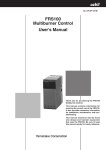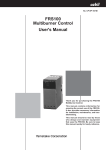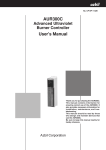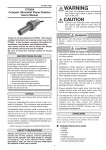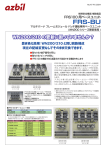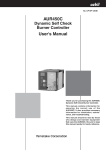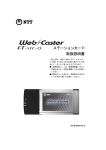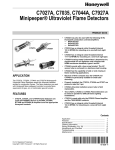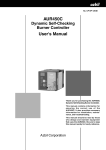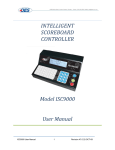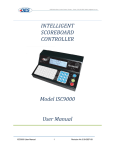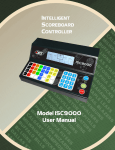Download FRS100 Multiburner Controller User`s Manual
Transcript
No. CP-SP-1074E FRS100 Multiburner Controller User's Manual Thank you for purchasing the FRS100 Multiburner Controller. This manual contains information for ensuring the correct use of the FRS100. It also provides necessary information for installation, maintenance, and troubleshooting. This manual should be read by those who design and maintain equipment that uses the FRS100. Be sure to keep this manual nearby for handy reference. NOTICE Be sure that the user receives this manual before the product is used. Copying or duplicating this user’s manual in part or in whole is forbidden. The information and specifications in this manual are subject to change without notice. Considerable effort has been made to ensure that this manual is free from inaccuracies and omissions. If you should find an error or omission, please contact Azbil Corporation. In no event is Azbil Corporation liable to anyone for any indirect, special or consequential damages as a result of using this product. © 1999-2012 Azbil Corporation All Rights Reserved. SAFETY PRECAUTIONS ■ About Icons The safety precautions described in this manual are indicated by various icons. Please be sure you read and understand the icons and their meanings described below before reading the rest of the manual. Safety precautions are intended to ensure the safe and correct use of this product, to prevent injury to the operator and others, and to prevent damage to property. Be sure to observe these safety precautions. WARNING Warnings are indicated when mishandling this product might result in death or serious injury. CAUTION Cautions are indicated when mishandling this product might result in minor injury to the user, or only physical damage to the product. ■ Examples Use caution when handling the product. The indicated action is prohibited. Be sure to follow the indicated instructions. i WARNING Use this device for batch operation of the burner (at least one start and stop in a 24-hour period). Do not use for continuous burner operation (nonstop combustion for 24 h or longer). This device does not have the prepurge and ignition sequencing functions required for burner ignition. Use this device as part of a system whose design gives careful consideration to the prepurge timer and sequence timing, following established safety guidelines. Wire terminals 1 and 2 so that they receive power continuously whenever the power switch is turned on. This is absolutely necessary to ensure operation of the self-check circuits at startup. Therefore, do not wire a thermostat between the power switch and terminal 1 or 2. Doing so might cause a serious combustion equipment accident. Connect loads (ignition transformer, solenoid valve, etc.) directly to the output terminals of this device. If they are not directly connected, combustion safety cannot be ensured. Do not allow the pilot or main burner "Safety Time" (ignition trial time) to exceed the specifications of the burner or equipment manufacturer. If they do, fuel may accumulate in the combustion chamber and form an explosive air-fuel mixture, resulting in a serious explosion hazard. Before removing, mounting, or wiring the FRS100, be sure to turn off the power to the FRS100 and all connected devices. Failure to do so might cause electric shock. Do not connect a solenoid valve to the high potential side of the circuit. If a ground fault occurs, the ground fault current may energize and open the solenoid valve. This device will not be able to prevent the valve from opening and fuel from flowing out. Even after the power to this device is turned off, terminal F continues to hold an electrical charge. To avoid electrical shock, do not touch terminal F. Carry out the pilot turndown test carefully. If the flame detector is set so that it detects a pilot flame that is too small to ignite the main burner, this device will not be able to detect a flame failure in the main burner. In that case, fuel will continue to be supplied, causing a serious explosion hazard. Before the pilot turndown test or ignition spark response test, make sure that all manual fuel valves are closed. ii WARNING If the pilot turndown test must be carried out repeatedly, completely shut down all equipment each time the test is finished, and completely discharge unburned gas or fuel that has accumulated in the ducts and combustion chamber. Failure to discharge unburned gas or fuel may result in an explosion. When the pilot turndown test is complete, turn OFF the power switch to shut down the power. Restore all test jumpers and limit interlock/regulator settings to their previous states. If operation begins without the above steps, damage to the equipment, gas leak or explosion may result. Do not start regular operation of the equipment without first completing the trial-run adjustments for this device, as well as the tests specified by the combustion equipment manufacturer. To prevent electric shock, turn the power off and discharge terminals F and G before removing this device from the subbase. Use lead wires to connect terminals F and G of the flame simulator (FSP300C100) to terminals F and G of this device for 10 seconds or more. CAUTION Installation, wiring, inspection, adjustment, etc. should be carried out by a trained and experienced technician who has knowledge and technical skills related to combustion equipment and flame safeguard control devices. Do not install where exposed to any of the following: • Certain chemicals or corrosive gases (ammonia, sulfur, chlorine, ethylene compounds, acid, etc.) • Splashing water or excessive humidity • High temperatures • Prolonged vibration If timers and auxiliary relays are needed for additional functions, select ones with high reliability, and be sure to design the circuit correctly. When installing and wiring, be sure to follow the instructions in this manual and in the user's manual for the combustion equipment. Make sure the flame detector does not detect ultraviolet rays other than those of the burner flame. If the flame detector responds to other ultraviolet rays, it will report that there is a flame even if the burner flame goes out. As a result, fuel will continue to be discharged, causing a very serious explosion hazard. iii CAUTION Follow all applicable regulations when doing the wiring work. Connect the blue signal lead from the AUD100 series Advanced Ultraviolet Flame Detector to terminal 5 and the white lead to terminal 6. Turning on the power when the flame detector is incorrectly wired could damage the AUD15C tube unit. Run the high-voltage ignition transformer cable separately and keep it at least 10 cm away from this device. Make sure that ignition transformer high-voltage cables are properly connected to prevent faulty contact. Faulty contact might generate high-frequency radio waves which can cause malfunction. The ignition transformer ground lead should be connected directly to the burner body or to a metallic part electrically connected to the burner body. Keep power lines and ignition transformer high-voltage cables separate from the flame detector wires. Always supply electric power at the voltage and frequency stated on the model label of this device. Always connect the power supply last. Otherwise, touching a terminal accidentally could result in electric shock or damage. In keeping with technical standards for electrical equipment, the burner body must have an earth ground connection with a resistance of less than 100 Ω. After the wiring is complete, be sure to check that it is correct. Incorrect wiring may cause damage or faulty operation. Make sure that the flame detector does not detect the ignition spark. If the flame detector can detect the spark, change the detector's line of sight or change the ignition electrode's position. Only an experienced technician who has knowledge and technical skills related to combustion equipment and combustion safety should carry out the pilot turndown test. This product is equipped with functions that are extremely important for the safe operation of combustion equipment. Carefully follow the instructions for its use that are given in this user's manual. iv CAUTION If the safety shutoff has been activated, check all of the items on the checklists in Chapter 3, ADJUSTMENTS FOR TRIAL OPERATION before restarting the equipment. Check the flame current at least once per month. Doing so can prevent shutdowns caused by a weak flame current signal. This device has an operating life. Assuming that the operating life of the combustion equipment used with this device is longer, be sure to do periodic maintenance and replacement of this device. In the event that this device is replaced, do all of the checks listed in Chapter 3, ADJUSTMENTS FOR TRIAL OPERATION. When doing a maintenance inspection of the burner, be sure to do the pilot turndown test. Inspection must be done at least once a year. Conduct periodic inspections in accordance with the user's manual of the equipment manufacturer. When cleaning the burner, clean the flame detector as well. Do not transport this device while it is mounted on a DIN rail. Remove it from the subbase and pack it in its original box. If it is transported while on a DIN rail, it might fall off and be damaged. v Conventions Used in This Manual The following conventions are used in this manual: Handling Precautions: Handling Precautions indicate items that the user should pay attention to when handling the FRS100. Note: (1), (2), (3): Notes indicate information that might benefit the user. Numbers within parentheses indicate steps in a sequence or parts of an explanation. vi Contents SAFETY PRECAUTIONS Conventions Used in This Manual Chapter 1. OVERVIEW AND PRODUCT CONFIGURATION ■ ■ ■ ■ ■ ■ ■ ■ Chapter 2. Overview • • • • • • • • • • • • • • • • • • • • • • • • • • • • • • • • • • • • • • • • • • • • • • • • • • • • • • • • • • • • • • • • • 1 Features • • • • • • • • • • • • • • • • • • • • • • • • • • • • • • • • • • • • • • • • • • • • • • • • • • • • • • • • • • • • • • • • • 1 System configuration • • • • • • • • • • • • • • • • • • • • • • • • • • • • • • • • • • • • • • • • • • • • • • • • • • • • 1 Security function • • • • • • • • • • • • • • • • • • • • • • • • • • • • • • • • • • • • • • • • • • • • • • • • • • • • • • • • • 2 Precautions for facility instrumentation• • • • • • • • • • • • • • • • • • • • • • • • • • • • • • • • • • 2 Model selection guide • • • • • • • • • • • • • • • • • • • • • • • • • • • • • • • • • • • • • • • • • • • • • • • • • • • • 3 Names of parts • • • • • • • • • • • • • • • • • • • • • • • • • • • • • • • • • • • • • • • • • • • • • • • • • • • • • • • • • • • 4 Configuration • • • • • • • • • • • • • • • • • • • • • • • • • • • • • • • • • • • • • • • • • • • • • • • • • • • • • • • • • • • • 4 MOUNTING AND WIRING 2-1 Mounting and Wiring the Subbase • • • • • • • • • • • • • • • • • • • • • • • • • • • • • • • • • • • • • • • • • • • 5 2-2 Wiring• • • • • • • • • • • • • • • • • • • • • • • • • • • • • • • • • • • • • • • • • • • • • • • • • • • • • • • • • • • • • • • • • • • • • • • • 8 ■ Manual ignition (intermittent pilot) • • • • • • • • • • • • • • • • • • • • • • • • • • • • • • • • • • • • • • • 9 ■ Burner flame monitoring only • • • • • • • • • • • • • • • • • • • • • • • • • • • • • • • • • • • • • • • • • • 14 ■ Wiring the flame detector • • • • • • • • • • • • • • • • • • • • • • • • • • • • • • • • • • • • • • • • • • • • • • • 19 ■ Wiring the solenoid valve • • • • • • • • • • • • • • • • • • • • • • • • • • • • • • • • • • • • • • • • • • • • • • • 20 ■ Wiring the surge absorber • • • • • • • • • • • • • • • • • • • • • • • • • • • • • • • • • • • • • • • • • • • • • • 21 Chapter 3. ADJUSTMENTS FOR TRIAL OPERATION ■ ■ ■ ■ ■ Chapter 4. Outline • • • • • • • • • • • • • • • • • • • • • • • • • • • • • • • • • • • • • • • • • • • • • • • • • • • • • • • • • • • • • • • • • • 22 How to measure the flame signal • • • • • • • • • • • • • • • • • • • • • • • • • • • • • • • • • • • • • • • 23 Pilot turndown test • • • • • • • • • • • • • • • • • • • • • • • • • • • • • • • • • • • • • • • • • • • • • • • • • • • • • 24 Ignition spark response test • • • • • • • • • • • • • • • • • • • • • • • • • • • • • • • • • • • • • • • • • • • • 26 Safety shutoff test • • • • • • • • • • • • • • • • • • • • • • • • • • • • • • • • • • • • • • • • • • • • • • • • • • • • • • 27 MAINTENANCE AND INSPECTION ■ Frequency of maintenance and inspection • • • • • • • • • • • • • • • • • • • • • • • • • • • • • 28 ■ Troubleshooting • • • • • • • • • • • • • • • • • • • • • • • • • • • • • • • • • • • • • • • • • • • • • • • • • • • • • • • • 29 Chapter 5. SPECIFICATIONS ■ Specifications • • • • • • • • • • • • • • • • • • • • • • • • • • • • • • • • • • • • • • • • • • • • • • • • • • • • • • • • • • 32 ■ External dimensions • • • • • • • • • • • • • • • • • • • • • • • • • • • • • • • • • • • • • • • • • • • • • • • • • • • • 33 vii Chapter 1. OVERVIEW AND PRODUCT CONFIGURATION ■ Overview The FRS100 Multiburner Controller is a combustion safety control with a safestart circuit, for use with manually ignited combustion equipment. To ensure safety, the FRS100 prevents ignition if anything abnormal is detected at start up, and shuts off the fuel valve if a flame failure occurs during operation. It is used in conjunction with the AUD100 series advanced ultraviolet flame detector or flame rod for batch operation of a burner. For continuous burner operation (nonstop combustion for 24 h or longer), instead of the FRS100, use the AUR350C, which has a continuous self-checking function. Because the FRS100 does not have an ignition function, it is used for systems in which an operator ignites the burner manually. This device should be used in combination with external instrumentation that supplies a purge function. Key Characteristics of the FRS100 Compatible burner operation type Purge function Ignition function Flame monitoring Batch No No Yes Behavior if flame failure occurs Does not recycle Compatible flame detectors AUD100C + AUD15C AUD110C + AUD15C Flame rod ■ Features • Upon equipment startup, the FRS100 checks both itself and the flame detector. If anything abnormal is detected, the FRS100 prevents ignition to ensure safety. • The FRS100 is designed to be compact, and can be plugged into the wiring sub-base. The sub-base can be mounted by screws or onto a DIN rail. • The power supply state and ignition detection can be verified easily from the LEDs on the front display. Completion of the start check is indicated by the LED on the center of the body behind the front cover. • Flame voltage output (0 to 5 Vdc) can be checked by the FSP136A100, or continuously monitored by a panel meter or recorder. • The FRS100 has a dedicated connector so that the optional FRS60A Flame Meter can be attached. ■ System configuration In terms of the overall system, the FRS100 serves as the flame monitoring device. It is used as shown in the diagram below. High limit controller Temperature controller Air pressure lower interlock FRS100 Air PS Flame detector L PS PS L Fuel MV Gas pressure lower interlock Exhaust T/C T/C Combustion chamber H MV PV PV IG Gas pressure upper interlock Ignition Combustion equipment transformer 1 Chapter 1. OVERVIEW AND PRODUCT CONFIGURATION ■ Security function The FRS100 is designed to ensure safety, and plays an important safety role by monitoring the burner operation and the flame. 1. Combustion monitoring and safety shutoff • Detects flame failure in the burner and quickly shuts off the fuel and shuts down the burner. • When an ignition failure, flame failure or flame-out occurs, the FRS100 follows a fixed sequence in shutting down each piece of equipment. 2. Startup, operation, and shutoff of combustion equipment • The FRS100 operates each device according to a predetermined sequence and timing. 3. Safe startup • At every startup signal, the FRS100 checks for false flame in the flame detector and flame detection circuit. • If a problem is detected, the FRS100 does not start the burner. 4. Redundant design • Maintains safety even if its own self-check circuit fails. • Will not deviate from the proper ignition sequence. ■ Precautions for facility instrumentation In designing facilities that use combustion safety devices, be sure to give careful consideration to the safety guidelines listed below. • For safety standards for industrial facilities using combustion equipment, see the technical guidelines published by the Ministry of Health, Labour and Welfare • For general safety rules for industrial combustion furnaces, see JIS B 8415. • For technical safety guidelines for gas combustion furnaces in industrial use, see publications by the Japan Gas Association. • For technical safety guidelines for gas boiler combustion equipment, see publications by the Japan Gas Association. ● Important points for ensuring safety 1. Connect the load directly to the FRS100. 2. Design the interlock so that it can directly cut off power to the load. 3. Be sure to use a safe startup circuit upon startup. 4. Do not set up a bypass, such as manual operation, for any load. 5. Have a redundant main valve and pilot valve. ● Precautions for system design Since the FRS100 does not have purge or ignition functions, they must be provided externally. 2 Chapter 1. OVERVIEW AND PRODUCT CONFIGURATION ■ Model selection guide Model Standard model High-sensitivity model Model No. Rated power supply Power consumption Flame failure response FRS100B100 100 Vac 50/60Hz FRS100B200 200 Vac 50/60Hz (when flame voltage is 2 V) FRS100B104 100 Vac 50/60Hz 2 s max. FRS100B204 200 Vac 50/60Hz (when flame voltage is 2 V) FRS100C100 100 Vac 50/60Hz FRS100C200 200 Vac 50/60Hz FRS100C300 220 Vac 50/60Hz FRS100C104 100 Vac 50/60Hz FRS100C204 200 Vac 50/60Hz FRS100C304 220 Vac 50/60Hz FRS100C150 100 Vac 50/60Hz FRS100C250 200 Vac 50/60Hz FRS100C350 220 Vac 50/60Hz FRS100C154 100 Vac 50/60Hz 2 s max. FRS100C254 200 Vac 50/60Hz (when flame voltage is 3.5 V) FRS100C354 220 Vac 50/60Hz 3W max. 7W max. 3 ±1 s Flame detector C7007A, C7008A Flame Rod C7012A*2, C7012C*2 Ultraviolet Flame Detector 3 ±1 s AUD100C + AUD15C (when flame voltage is 4.2 V) AUD110C + AUD15C Advanced Ultraviolet Flame Detector 2 s max. C7035A*1, C7027A*1 (when flame voltage is 4.2 V) Minipeeper Ultraviolet Flame Detector 7W max. 3 ±1 s (when flame voltage is 3.5 V) *1. Discontinuation date: Dec. 2011. *2. Discontinuation date: March 2012. 3 Chapter 1. OVERVIEW AND PRODUCT CONFIGURATION ■ Names of parts ● FRS100 body Cover ● FRS50A100 subbase (sold separately) ■ Configuration ● Flame Detector FRS100B Name FRS100C Name Model No. Ultraviolet Flame Detector C7012A/C*2 Flame Rod C7007A, C7008A *2. Discontinuation date: March 2012. Model No. Advanced Ultraviolet Flame Detector AUD100C + AUD15C AUD110C + AUD15C Minipeeper Ultraviolet Flame C7035A*1, C7027A*1 Detector *1. Discontinuation date: Dec. 2011. ● Optional Parts (sold separately) Name Subbase Model No. FRS50A100 Flame simulator for FSP300C100 AUD100C/110C + AUD15C, C7035A*1, C7027A*1 Name Model No. Flame Meter RS60A Flame Simulator for Flame Rod Lightning surge absorber 123514A 83968019-001 *1. Discontinuation date: Dec. 2011. 4 Chapter 2. 2 - 1 MOUNTING AND WIRING Mounting and Wiring the Subbase CAUTION Do not install where exposed to any of the following: • Certain chemicals or corrosive gases (ammonia, sulfur, chlorine, ethylene compounds, acid, etc.) • Splashing water or excessive humidity • High temperatures • Prolonged vibration Do not transport this device while it is mounted on a DIN rail. Remove it from the subbase and pack it in its original box. If it is transported while on a DIN rail, it might fall off and be damaged. When installing and wiring, be sure to follow the instructions in this manual and in the user's manual for the combustion equipment. ● Mounting location Maintain space around the control as shown below for heat radiation, and to facilitate mounting, removal, wiring and maintenance. Above: 50 mm min. Above: 50 mm min. PRS 100 FLAM E RELAY POWER FLAME PRS 100 FLAM E RELAY PRS 100 FLAM E RELAY POWER POWER FLAME FLAME 20 mm min. 20 mm min. 20 mm min. 20 mm min. Below: 20 mm min. Below: 20 mm min. Gang-mounting (Allowable ambient temperature upper limits: 45 °C) Stand-alone mounting (Allowable ambient temperature upper limits: 60 °C) Handling Precautions • If there is room, leave as much space as possible between the FRS and other FRS units to allow for heat radiation. • If ambient temperature is close to the allowable upper limit, reduce the internal temperature of the control panel by mounting a panel cooler or a cooling fan. Allowable ambient temperature upper limits • Gang-mounting: 45 °C • Stand-alone mounting: 60 °C 5 Chapter 2. MOUNTING AND WIRING ● Mounting direction • Mount in a vertical plane so that the arrow on the subbase is facing upwards. • Mount so that the indicators are at the top of the front panel. PRS 100 FLA ME RE LAY POWER Indicator FLAME • Do not mount as shown below. ● DIN rail mounting (1) Pull the DIN rail mounting plate downwards. (2) Place the subbase on the DIN rail so that the arrow on the subbase is facing upwards. (3) Lock the subbase to the DIN rail by pushing the mounting plate upward. UP UP Pull down 6 Mount the subbase UP Push the DIN rail mounting plate upward Chapter 2. MOUNTING AND WIRING (4) Wire the subbase terminals as instructed in 2-2 Wiring. (5) Pull the bottom of the controller cover downwards to remove. (6) Press the controller into the subbase with the display facing upwards. (7) Tighten the mounting screw on the center of the body to fix onto the subbase with a maximum torque of 0.3 N•m. FRS100 Subbase Push the FRS100 into the subbase E LAY FRS 100 FLAME R POWER UP FLAME E LAY FRS 100 FLAME R POWER FLAME Tighten the screw and fix Cover Flame voltage meter terminals (8) If necessary, wire the flame voltage meter terminals. (9) Mount the cover on the control body. ● Direct panel mounting (1) Drill two M4 mounting holes in the panel so that the arrow on the subbase will be facing upward. 32 UP M4 (2 locations) (2) Attach the subbase to the panel using two M4 screws at a maximum torque of 0.7 N•m. Handling Precautions • Do not tighten the subbase mounting screws using a torque exceeding the maximum torque. Doing so might damage the subbase. (3) Wire the subbase terminals as instructed in 2-2 Wiring. (4) Pull the bottom of the controller cover downwards to remove. (5) Press the controller into the subbase with the display facing upwards. (6) Tighten the mounting screw on the center of the body to fix onto the subbase with a maximum torque of 0.3 N•m. (7) If necessary, wire the flame voltage meter terminals. (8) Mount the cover on the control body. 7 Chapter 2. MOUNTING AND WIRING 2 - 2 Wiring WARNING Wire terminals 1 and 2 so that they receive power continuously whenever the power switch is turned on. This is absolutely necessary to ensure operation of the self-check circuits at startup. Therefore, do not wire a thermostat between the power switch and terminal 1 or 2. Doing so might cause a serious combustion equipment accident. Connect loads (ignition transformer, solenoid valve, etc.) directly to the output terminals of this device. If they are not directly connected, combustion safety cannot be ensured. CAUTION If timers and auxiliary relays are needed for additional functions, select ones with high reliability, and be sure to design the circuit correctly Make sure the load connected to each terminal does not exceed the rating indicated in the specifications. When installing and wiring, be sure to follow the instructions in this manual and in the user's manual for the combustion equipment. Follow all applicable regulations when doing the wiring work. Run the high-voltage ignition transformer cable separately and keep it at least 10 cm away from this device. Make sure that ignition transformer high-voltage cables are properly connected to prevent faulty contact. Faulty contact might generate highfrequency radio waves which can cause malfunction. The ignition transformer ground lead should be connected directly to the burner body or to a metallic part electrically connected to the burner body. Keep power lines and ignition transformer high-voltage cables separate from the flame detector wires. Always supply electric power at the voltage and frequency stated on the model label of this device. Always connect the power supply last. Otherwise, touching a terminal accidentally could result in electric shock or damage. In keeping with technical standards for electrical equipment, the burner body must have an earth ground connection with a resistance of less than 100 Ω. After the wiring is complete, be sure to check that it is correct. Incorrect wiring may cause damage or faulty operation. 8 Chapter 2. MOUNTING AND WIRING ■ Manual ignition (intermittent pilot) High potential Low potential Blower on-off circuit / Prepurge circuit Limit/Interlock circuit (limit switch, interlock switch) Power 1 2 Power circuit 1K Ignition switch Start check circuit Prepurge completion Burner start signal contacts 7 Operation input circuit 8 Ignition transformer Pilot valve 1 Pilot valve 2 3 1K 2K 4 Main valve 1 Main valve 2 (F) Flame detector (G) 2K 5 6 − A Flame amplifier circuit B Internal circuit + Combustion lamp Flame voltage 0-5 Vdc * Subbase * The combustion lamp lights up when the ignition switch is turned on. Handling Precautions • If the power supply high potential and low potential are differentiated, connect the high potential to terminal 1 and the low potential to terminal 2. 9 Chapter 2. MOUNTING AND WIRING ● Explanation of operation • Normal operation and shutdown No 1 2 3 4 5 6 Input status Power ON Blower operation FRS100 activity Receives power across terminals 1 and 2. If the limit switch and interlock status is normal, the blower starts. After completion of the prepurge, the prepurge completion signal is transmitted to allow execution of the next operation. Burner start If the limit switch and interlock status is normal contacts ON (limit switch contacts closed), when the burner start contacts are closed, power is applied across terminals 7 and 2. Relay 1K turns on after completion of the start check. Ignition switch ON When the ignition switch is pushed (contacts closed), power is applied from terminal 8 to the pilot valve and ignition transformer. The ignition transformer turns on, the pilot valve opens, and the combustion lamp lights up. The flame detector detects the pilot burner flame, and relay 2K turns on, allowing power to be supplied through terminal 4. Ignition switch OFF Since the ignition switch contacts are open, power to the ignition transformer is cut, and ignition transformer operation stops. Because power is supplied through relays 1K and 2K, power through terminal 4 continues to maintain the operation of the pilot valve. When the ignition switch is turned off, its N.C. contacts close, supplying power to the main valve, which opens. Blower stop Since the prepurge completion signal has been discontinued, the power across terminals 7 and 2 is cut, relay 1K turns off, and the power to terminal 4 is also cut. The pilot and main valves close, and the combustion lamp turns off. All loads are de-energized, and when the flame detector detects the flame failure, relay 2K turns off. The FRS100 returns to standby status and waits for the next start signal. (3)Burner start contacts ON (2)Blower operation (1)Power ON Output activity (POWER LED lights up) (Start check operation LED lights up) • Ignition transformer ON • Pilot valve opens • Combustion lamp lights up • (FLAME LED lights up) • Ignition transformer OFF • Pilot valve continues open • Main valve opens • Pilot valve closes • Main valve closes (FLAME LED turns off) • Combustion lamp turns off • (Start check operation LED turns off) Start check (2s) (4)Ignition switch ON Flame detection (5)Ignition switch OFF (5-10s) (6)Blower stop Limit/Interlock contacts Blower operation Prepurge Prepurge completion signal Burner start contacts (term.7-2) Ignition transformer Pilot valve Main valve Combustion lamp POWER LED FLAME LED Start check LED Elapsed time Note: It is possible that relay 2K may turn ON when the power is turned on. 10 Chapter 2. MOUNTING AND WIRING • Ignition failure No 1 2 3 4 5 6 Input status Power ON Blower operation FRS100 activity Receives power across terminals 1 and 2. If the limit switch and interlock status is normal, the blower starts. After completion of the prepurge, the prepurge completion signal is transmitted to allow execution of the next operation. Burner start If the limit switch and interlock status is normal contacts ON (limit switch contacts closed), when the burner start contacts are closed, power is applied across terminals 7 and 2. Relay 1K turns on after completion of the start check. Ignition switch ON When the ignition switch is pushed (contacts closed), power is applied from terminal 8 to the pilot valve and ignition transformer. The ignition transformer turns on, the pilot valve opens, and the combustion lamp lights up. If the pilot burner fails to ignite, the flame detector cannot detect the pilot burner flame, and relay 2K does not turn on. Ignition switch OFF Since the ignition switch contacts are open, power to the ignition transformer, pilot valve, and combustion lamp is cut off. Accordingly, ignition transformer operation stops, the pilot valve closes, and the combustion lamp turns off. Also, because relay 2K is not ON, the voltage from terminal 4 by way of relays 1K and 2K is zero. Therefore, no voltage is supplied to the main valve, which does not open. Blower stop Power across terminals 7 and 2 is cut, and relay 1K turns off. The FRS100 returns to standby status and waits for the next start signal. (3)Burner start contacts ON (2)Blower operation (1)Power ON Output activity (POWER LED lights up) (Start check operation LED lights up) • Ignition transformer ON • Pilot valve opens • Combustion lamp lights up • Ignition transformer OFF • Pilot valve closes • Combustion lamp turns off (Start check operation LED turns off) Start check (2s) (4)Ignition switch ON No flame detection (5)Ignition switch OFF (5-10s) (6)Blower stop Limit/Interlock contacts Blower operation Prepurge Prepurge completion signal Burner start contacts (term.7-2) Ignition transformer Pilot valve Main valve Combustion lamp POWER LED FLAME LED Start check LED Elapsed time Note: It is possible that relay 2K may turn ON when the power is turned on. 11 Chapter 2. MOUNTING AND WIRING • Flame failure during combustion No 1 2 3 4 5 6 7 Input status Power ON FRS100 activity If the limit switch and interlock status is normal, the blower starts. After completion of the prepurge, the prepurge completion signal is transmitted to allow execution of the next operation. Blower operation If the limit switch and interlock status is normal, the blower starts. The prepurge completion signal is transmitted to allow execution of the next operation. Burner start If the limit switch and interlock status is normal contacts ON (limit switch contacts closed), when the burner start contacts are closed, power is applied across terminals 7 and 2. Relay 1K turns on after completion of the start check. Ignition switch ON When the ignition switch is pushed (contacts closed), power is applied from terminal 8 to the pilot valve and ignition transformer. The ignition transformer turns on, the pilot valve opens, and the combustion lamp lights up. The flame detector detects the pilot burner flame, and relay 2K turns on, allowing power to be supplied through terminal 4. Ignition switch OFF Since the ignition switch contacts are open, power to the ignition transformer is cut, and ignition transformer operation stops. Because power is supplied through relays 1K and 2K, power through terminal 4 continues to maintain the operation of the pilot valve. When the ignition switch is turned off, its N.C. contacts close, supplying power to the main valve, which opens. Flame failure occurs Relay 2K turns off after the flame response period, the voltage that was supplied from terminal 4 is cut off, the pilot valve and the main valve close, and the combustion lamp turns off. Blower stop Power across terminals 7 and 2 is cut, and relay 1K turns off. The FRS100 returns to standby status and waits for the next start signal. (3)Burner start contacts ON (2)Blower operation (1)Power ON Output activity (POWER LED lights up) (Start check operation LED lights up) • Ignition transformer ON • Pilot valve opens • Combustion lamp lights up • (FLAME LED lights up) • Ignition transformer OFF • Pilot valve continues open • Main valve opens • (FLAME LED turns off) • Pilot valve closes • Main valve closes • Combustion lamp turns off (Start check operation LED turns off) Start check (2s) (4)Ignition switch ON (6)Flame failure Flame response Flame detection (7)Blower stop (5)Ignition switch OFF (5-10s) Limit/Interlock contacts Blower operation Prepurge Prepurge completion signal Burner start contacts (term.7-2) Ignition transformer Pilot valve Main valve Combustion lamp POWER LED FLAME LED Start check LED Elapsed time 12 Note: It is possible that relay 2K may turn ON when the power is turned on. Chapter 2. MOUNTING AND WIRING • False flame detection during startup No 1 2 3 4 5 6 Input status Power ON Blower operation FRS100 activity Output activity Receives power across terminals 1 and 2. (POWER LED lights up) If the limit switch and interlock status is normal, the blower starts. After completion of the prepurge, the prepurge completion signal is transmitted to allow execution of the next operation. Flame detection Relay 2K is turned on by a false flame signal. (FLAME LED lights up) Burner start If the limit switch status is normal (limit switch contacts ON contacts closed),when the start contacts are closed power is applied across terminals 7 and 2. The start check is carried out, and relay 1K does not turn on because a false flame is detected. Ignition switch ON Even though the ignition switch contacts are closed, no voltage is applied to terminal 8, and so the ignition transformer and the pilot valve do not operate. Ignition switch OFF No voltage is supplied from terminal 4, and the load is not energized. Blower stop The power across terminals 7 and 2 is cut off, and the FRS100 returns to standby status and waits for the next start signal. If the false flame signal is continuous, the FLAME LED is also ON continuously. (3)Burner start contacts ON Flame detection (2)Blower operation (1)Power ON Start check (2s) (4)Ignition switch ON (6)Blower stop (5)Ignition switch OFF (5-10s) Limit/Interlock contacts Blower operation Prepurge Prepurge completion signal Burner start contacts (term.7-2) Ignition transformer Pilot valve Main valve Combustion lamp POWER LED FLAME LED Start check LED Elapsed time Note: It is possible that relay 2K may turn ON when the power is turned on. 13 Chapter 2. MOUNTING AND WIRING ■ Burner flame monitoring only (In a case where the FRS100 is not used in its usual combustion safety role of shutting valves, etc.) High potential Low potential Power 1 1K Burner start contacts Start check circuit 7 Operation input circuit 1K Contact output common 2K 5 (G) 6 8 Start check completion 4 Flame output 2K 3 (F) Flame detector 2 Power circuit Flame amplifier circuit Internal circuit – A B Flame voltage 0-5 Vdc + Subbase Handling Precautions • If the power supply high potential and low potential are differentiated, connect the high potential to terminal 1 and the low potential to terminal 2. 14 Chapter 2. MOUNTING AND WIRING ● Explanation of operation • Normal operation No 1 2 Input status Power ON Start contacts ON 3 Flame detection 4 Start contacts OFF FRS100 activity Power is applied across terminals 1 and 2. When the start contacts are closed power is applied across terminals 7 and 2. After completion of the start check, relay 1K turns on. Since relay 1K turns on, the start check completion output from terminal 8 turns on. The flame detector detects the flame of the pilot burner. Relay 2K turns on. Since relay 2K turns on, the flame output from terminal 4 turns on. The power supplied across terminals 7 and 2 is cut off, relay 1K turns off, and the power to terminals 4 and 8 is also cut off. The start check completion output and flame output turn off. Since the flame detector detects a flame failure, relay 2K turns off. The FRS100 returns to standby status and waits for the next start signal. (1)Power ON (2)Start contacts ON Start check (2s) Output activity (POWER LED lights up) • (Start check LED lights up) • Start check completion output ON • (FLAME LED lights up) • Flame output ON • (Start check LED turns off) • Start check completion output OFF • (FLAME LED turns off) • Flame output OFF (4)Start contacts OFF (3)Flame detection Start contact (term.7-2) Start check completion Flame output POWER LED FLAME LED Start check LED Elapsed time Note: It is possible that relay 2K may turn ON when the power is turned on. 15 Chapter 2. MOUNTING AND WIRING • Ignition failure No 1 2 Input status Power ON Start contacts ON 3 Ignition failure 4 Start contacts OFF FRS100 activity Power is applied across terminals 1 and 2. When the start contacts are closed power is applied across terminals 7 and 2. After completion of the start check, relay 1K turns on. Since relay 1K turns on, the start check completion output from terminal 8 turns on. If the burner does not ignite, the flame detector does not detect a burner flame, and relay 2K does not turn on. The power supplied across terminals 7 and 2 is cut off, relay 1K turns off, power to terminals 4 and 8 is cut off, and the start check completion output turns off. The FRS100 returns to standby status and waits for the next start signal. (1)Power ON (2)Start contacts ON Start check (2s) Output activity (POWER LED lights up) • (Start check operation LED lights up) • Start check completion output ON • (Start check LED turns off) • Start check completion output OFF (4)Start contacts OFF Start contact (term.7-2) Start check completion Flame output POWER LED FLAME LED Start check LED Elapsed time Note: It is possible that relay 2K may turn ON when the power is turned on. 16 Chapter 2. MOUNTING AND WIRING • Flame failure during combustion No 1 2 3 4 5 Input status Power ON Start contacts ON FRS100 activity Power is applied across terminals 1 and 2. When the start contacts are closed power is applied across terminals 7 and 2. After completion of the start check, relay 1K turns on. Since relay 1K turns on, the start check completion output from terminal 8 turns on. Flame detection The flame detector detects the flame of the pilot burner. Relay 2K turns on. Since relay 2K turns on, the flame output from terminal 4 turns on. Flame failure occurs After the flame response period, relay 2K turns off, the voltage supplied from terminal 4 is cut off, and the flame output turns off. Start contacts OFF The power supplied across terminals 7 and 2 is cut off, relay 1K turns off, power to terminals 4 and 8 is cut off, and the start check completion output turns off. The FRS100 returns to standby status and waits for the next start signal. (1)Power ON (2)Start contacts ON Start check (2s) (3)Flame detection Output activity (POWER LED lights up) • (Start check operation LED lights up) • Start check completion output ON • (FLAME LED lights up) • Flame output ON • (FLAME LED turns off) • Flame output OFF • (Start check LED turns off) • Start check completion output OFF (4)Flame failure Flame response (5)Start contacts OFF Start contact (term.7-2) Start check completion Flame output POWER LED FLAME LED Start check LED Elapsed time Note: It is possible that relay 2K may turn ON when the power is turned on. 17 Chapter 2. MOUNTING AND WIRING • False flame is detected at startup No 1 2 Input status Power ON Flame detection Start contacts ON 3 Start contacts OFF FRS100 activity Output activity Power is applied across terminals 1 and 2. (POWER LED lights up) Relay 2K is turned on by a false flame signal. (FLAME LED lights up) When the start contacts are closed power is applied across terminals 7 and 2. The start check is carried out, and relay 1K does not turn on because a false flame is detected. Power across terminals 7 and 2 is cut off. The FRS100 returns to standby status and waits for the next start signal. If the false flame signal is continuous, the FLAME LED is also ON continuously. (1)Power ON Flame detection (2)Start contacts ON Start check (2s) (3)Start contacts OFF Start contact (term.7-2) Start check completion Flame output POWER LED FLAME LED Start check LED Elapsed time Note: It is possible that relay 2K may turn ON when the power is turned on. 18 Chapter 2. MOUNTING AND WIRING ■ Wiring the flame detector CAUTION If the FRS100C is used, connect the AUD110C detector’s signal leads from terminals F and G to terminals 5 (F) and 6 (G) of the FRS respectively. In the case of the AUD100C, connect the detector’s blue signal lead to terminal 5 (F) and the white lead to terminal 6 (G). Turning on the power when the flame detector is incorrectly wired could damage the AUD15C tube unit. ● Wiring between an AUD100 series sensor and the FRS100C AUD110C + AUD15C AUD100C + AUD15C Terminal F 5 6 • G 5 (F) Blue (F) 6 (G) White (G) Allowable lead length • Type of signal lead • Allowable lead length 2 mm2, 600 Vac IV (indoor vinyl) insulated power lead Approx. 200 m ● Wiring between the Flame Rod and the FRS100B Flame rod (F) (G) • Allowable lead length • Type of signal lead • Allowable lead length Terminal 5 Terminal 6 High-frequency coaxial cable 5C2V, 7C2V Approx. 30 m 19 Chapter 2. MOUNTING AND WIRING ■ Wiring the solenoid valve CAUTION Do not connect a solenoid valve to the high potential of the circuit. If a ground fault occurs, the ground fault current may energize and open the solenoid valve. This device will not be able to prevent the valve from opening and fuel from flowing out. ● Correct connection FRS100 100 V Burner Power Low potential (G) N (Ground fault) L Combustion unit High potential (H) Valve (closed) Fuel Ground current will not flow to the solenoid valve if the valve is wired as shown in the figure above, even if faulty insulation on the high potential (H) causes a ground fault. Accordingly, the valve will not open, eliminating the risk of fuel discharge. ● Wrong connection (Ground fault) FRS100 Burner Power 100 V Low potential (G) N L Combustion unit High potential (H) Valve (open) Fuel Ground current will flow to the solenoid valve if the valve is wired as shown in the figure above and if a ground fault occurs. Accordingly, the solenoid valve will open regardless of the flame relay, causing fuel discharge. 20 Chapter 2. MOUNTING AND WIRING ■ Wiring the surge absorber Wire as shown below when using a surge absorber (model No.83968019-001, ordered separately) for protection from lightning surge. Handling Precautions • Use a JIS C 3306, 0.75 mm2 power lead (lead diameter 0.18, 30-strand) or higher for wiring to the power supply. • Attach a straight terminal (equivalent to a 187 series receptacle, made by TE Connectivity) to one end of the power lead, and keep the wire as short as possible. • Since the surge absorber mounting bracket is crimped internally to make contact with the low potential side, electricity can flow between them. To ground the bracket, attach it to a grounded metal part such as the burner housing. 21 Chapter 3. ADJUSTMENTS FOR TRIAL OPERATION WARNING Do not allow the pilot or main burner "Safety Time" (ignition trial time) to exceed the specifications of the burner or equipment manufacturer. If they do, fuel may accumulate in the combustion chamber and form an explosive airfuel mixture, resulting in a serious explosion hazard. Even after the power to this device is turned off, terminal F continues to hold an electrical charge. To avoid electrical shock, do not touch terminal F. Before the pilot turndown test or ignition spark response test, make sure that all manual fuel valves are closed. Do not start regular operation of the equipment without first completing the trial-run adjustments for this device, as well as the tests specified by the equipment manufacturer. CAUTION Installation, wiring, inspection, adjustment, etc. should be carried out by a trained and experienced technician who has knowledge and technical skills related to combustion equipment and flame safeguard control devices. Check the flame current at least once per month. Doing so can prevent shutdowns caused by a weak flame current signal. ■ Outline The following table shows the test adjustment items described in this chapter: Item Applicable Unit Flame signal measurement method All units Pilot turndown test Units using the pilot burner Ignition spark response test All units Safety shutdown test All units Handling Precautions • After adjusting the above items, make sure that all of the adjustment requirements are satisfied. All of the adjustment requirements must be satisfied by the final mounting position of the flame detector. ● Required equipment • Tester (input impedance, 100 kΩ or more) Range: 0 to 300 Vac, 0 to 5 Vdc • Two jumper leads with crocodile clips, AWG14 (2 mm2) or more, approximately 30 cm long. • Insulation tester: 500 Vdc megger ● Preliminary inspection • Check all connections. • Make sure that the controller is mounted at a location within the allowable ambient temperature. 22 Chapter 3. ADJUSTMENTS FOR TRIAL OPERATION • Make sure that the flame detector is properly mounted. (Refer to its instruction manual.) • Disconnect the loads and flame detector wiring. Measure the insulation resistance across the terminals and panel ground, and make sure that the resistance is 50 MΩ or more using an insulation tester or megger of 500 Vdc or more. • Check that all fuel valves and cocks are closed, and the combustion chamber has been completely vented. ■ How to measure the flame signal Handling Precautions • When using the high-sensitivity model, limit the flame voltage to 4.5 V or less. (1) Start the controller, and measure the flame voltage for each burner under various conditions (at startup, normal operation, etc.). (2) When measuring the flame voltage, insert the tester probes into the holes to connect to terminals A and B at the bottom front of the controller as shown below. FRS100 FLAME RELAY POWER FLAME Terminal A Terminal B Tester Input impedance, 100 kΩ or more Black Red + – 0 to 5 Vdc range (3) Refer to the following table for voltage values: Recommended flame voltage Checklist • Make sure that flame monitoring is correct. Stable 2.0 Vdc or more • The viewing window of the flame detector must be free of dirt. • The monitoring tube must not be blocked with soot. (4) If the flame signal fluctuates, check the flame detector mounting position and wiring again. 23 Chapter 3. ADJUSTMENTS FOR TRIAL OPERATION ■ Pilot turndown test WARNING Do not allow the pilot or main burner "Safety Time" (ignition trial time) to exceed the specifications of the burner or equipment manufacturer. If they do, fuel may accumulate in the combustion chamber and form an explosive air-fuel mixture, resulting in a serious explosion hazard. Carry out the pilot turndown test carefully. If the flame detector is set so that it detects a pilot flame that is too small to ignite the main burner, this device will not be able to detect a flame failure in the main burner. In that case, fuel will continue to be supplied, causing a serious explosion hazard. Before the pilot turndown test or ignition spark response test, make sure that all manual fuel valves are closed. If the pilot turndown test must be carried out repeatedly, completely shut down all equipment each time the test is finished, and completely discharge unburned gas or fuel that has accumulated in the ducts and combustion chamber. Failure to discharge unburned gas or fuel may result in an explosion. When the pilot turndown test is complete, turn OFF the power switch to shut down the power. Restore all test jumpers and limit interlock/regulator settings to their previous states. If operation begins without the above steps, damage to the equipment, gas leak or explosion may result. CAUTION Only an experienced technician who has knowledge and technical skills related to combustion equipment and combustion safety should carry out the pilot turndown test. This test is intended to check that the flame is reliably transferred to the main burner when the flame detector detects the pilot flame, even if gas pressure and air pressure change to their worst conditions. Handling Precautions • If a fuel pressure limit switch is used, and its contacts are open, turn it ON with a jumper cable during this test. ● Test procedure (1) Turn the operation switch OFF. (2) Close the manual valves to stop the gas supply to the pilot burner and main burner. (3) Open the manual valve to the pilot burner. (4) Turn the power switch ON, and then turn the start switch on, and press and hold the ignition switch. The pilot will ignite and the pilot valve will open. Ignition will begin and the combustion lamp will light. Release the ignition switch. 24 Chapter 3. ADJUSTMENTS FOR TRIAL OPERATION (5) Close the pilot manual valve slowly. The pilot flame will gradually grow smaller. Continue to close the manual valve until the flame detector can not detect the flame. Record the gas pressure immediately before the flame relay turns OFF and the combustion lamp is lit up. (6) Open the manual valve for the pilot slowly to adjust the pressure to a level immediately before the combustion lamp goes off. Then, press the ignition switch again to ignite the pilot. (7) Release the ignition switch. Open the manual valve for the main burner and check that the main burner ignites smoothly within one second after the valve is opened. (8) Try different gas pressures between the minimum and maximum levels, igniting the main burner five or six times. Make sure that the main burner ignites smoothly every time. (9) If the main burner does not ignite properly, the reason is probably that the pilot flame is too small. Increase the size of the pilot flame, and carry out the following adjustment: • Either slightly take the monitor line of the flame detector away from the axis of the pilot flame, or stop the iris down to correct the visible flame size. (Set the flame size so that the main pilot ignites smoothly at the minimum flame sensitivity.) (10) After making this adjustment, repeat steps 5 to 8, and make sure that main burner ignition is reliable. (11) When this test is completed, return the manual valve for the main burner to its fully open position. Check that the flame signal is appropriate. (12) If any limit switch has jumper cables attached, disconnect them to return the limit switch to its previous state. 25 Chapter 3. ADJUSTMENTS FOR TRIAL OPERATION ■ Ignition spark response test CAUTION Make sure that the flame detector does not detect the ignition spark. If the flame detector can detect the spark, change the detector's line of sight or change the ignition electrode's position. Make sure the flame detector does not detect ultraviolet rays other than those of the burner flame. If the flame detector responds to other ultraviolet rays, it will report that there is a flame even if the burner flame goes out. As a result, fuel will continue to be discharged, causing a very serious explosion hazard. This test should be carried out on any equipment that uses an ultraviolet flame detector. The test is to check that the ultraviolet flame detector does not respond to UV rays emitted from the ignition spark. ● AUD100 series advanced ultraviolet flame detector Carry out the following test to check that the AUD100 series advanced ultraviolet flame detector or flame rod does not respond to the UV rays emitted from the ignition spark (so that the FLAME LED does not light up). (1) Close the manual fuel valves to the pilot and main burners. (2) Start the combustion equipment and measure the flame voltage in the pilot ignition sequence to check whether or not there is an effect on the flame voltage. (3) If the FLAME LED is lit, make adjustments using the following procedure while referring to the equipment user’s manual. • Move of the AUD100 series or flame rod so that there is no effect. • Put a shielding plate in the optical path of the AUD100 series so that the effect of the spark on the flame voltage is 0.4 Vdc or less. 26 Chapter 3. ADJUSTMENTS FOR TRIAL OPERATION ● Cautions regarding UV sources other than flames The table below shows various radiation sources other than the burner flame that may activate the flame detector. Make sure that the flame voltage is not affected under any conditions of the flame response test. Ultraviolet ray sources Red-hot chamber wall with temperature 1371 °C or more Sparks • Ignition transformer • Welding arc • Lightning Gas laser Sunlamp Germicidal lamp Strong flashlight (toward UV sensor) Gamma ray and X-ray sources Regression analyzer Electron microscope X-ray camera High-voltage vacuum switch High-voltage capacitor Radioactive isotope Other sources producing ultraviolet rays, gamma rays and X-rays ■ Safety shutoff test After all operational adjustments have been completed, carry out the safety shutoff test. • Pilot ignition failure (ignition failure) (1) Close the manual fuel valves to the pilot and main burners. (2) Press the ignition switch to begin combustion. (3) The pilot valve opens for pilot burner ignition, but ignition is not possible. Check that the FLAME LED does not light up, and the main valve does not open. Do not hold the ignition switch for a long time. • Flame failure during normal combustion (1) Open the pilot and main manual fuel valves. (2) Press the ignition switch to start operation. (3) When the sequence has progressed correctly and normal combustion (main valve open) has begun, close the pilot and main manual fuel valves to put out the burner flame. Then, check that the flame failure is detected and that safety shutoff occurs correctly. 27 Chapter 4. MAINTENANCE AND INSPECTION WARNING Before removing, mounting, or wiring the FRS100, be sure to turn off the power to the FRS100 and all connected devices. Failure to do so might cause electric shock. Even after the power to this device is turned off, terminal F continues to hold an electrical charge. To avoid electrical shock, do not touch terminal F. To prevent electric shock, turn the power off and discharge terminals F and G before removing this device from the subbase. Use lead wires to connect terminals F and G of the flame simulator (FSP300C100) to terminals F and G of this device for 10 seconds or more. CAUTION Installation, wiring, inspection, adjustment, etc. should be carried out by a trained and experienced technician who has knowledge and technical skills related to combustion equipment and flame safeguard control devices. Conduct periodic inspections in accordance with the user's manual of the equipment manufacturer. If the safety shutoff has been activated, check all of the items on the checklists in Chapter 3, ADJUSTMENTS FOR TRIAL OPERATION before restarting the equipment. When doing a maintenance inspection of the burner, be sure to do the pilot turndown test. Inspection must be done at least once a year. When cleaning the burner, clean the flame detector as well. This device has an operating life. Assuming that the operating life of the combustion equipment used with this device is longer, be sure to do periodic maintenance and replacement of this device. In the event that this device is replaced, do all of the checks listed in Chapter 3, ADJUSTMENTS FOR TRIAL OPERATION. ■ Frequency of maintenance and inspection Determine an inspection cycle taking into consideration the following factors: • Type of equipment • Ambient conditions of installation site (dust, temperature, etc.) • The effect of burner failure on equipment operation. (1) Carry out the safety shutoff test described in Chapter 3, ADJUSTMENTS FOR TRIAL OPERATION at least once a month. (2) Measure the flame voltage at least once a month. (3) Check the viewing window on the AUD100 series advanced ultraviolet flame detector, the flame rod, etc. for dirt, and clean as necessary. (4) Check the ambient temperature. (5) If equipment will be seriously damaged by a burner failure, carry out this inspection more frequently. 28 Chapter 4. MAINTENANCE AND INSPECTION ■ Troubleshooting If a problem occurs, remove the front cover of the controller. Determine the operating state of the controller and type of trouble by checking the start check, POWER and FLAME LED display states. The start check LED is located in the center inside the cover, and the POWER and FLAME LEDs are located on the front display. ❍ LED out ● LED lit Before startup, terminal 7 OFF After startup, terminal 7 ON POWER LED Start check LED FLAME LED Results ❍ ❍ ❍ ● ● ● The flame is being detected. (normal operation) ● ● ❍ The flame has not been detected. Check flame detector, burner, flame relay, valves, ignition transformer and flame relay.* ● ❍ ● False flame Check burner flame, flame detector and flame relay.* ● ❍ ❍ 1K relay is not ON. Check power supply at operation input terminal (7). Check flame relay.* The power is not ON. Remedy (check items) Check panel power switch and wiring. - * To check if the controller is operating correctly, apply a flame signal input to the controller by using a flame simulator. Make sure that 2K relay is turned ON and the FLAME LED is lit. 29 Chapter 4. MAINTENANCE AND INSPECTION ● Wiring check of AUD100C/110C Advanced Ultraviolet Flame Detector used with the FRS100C Check that the wiring to the AUD100C/110C Advanced Ultraviolet Flame Detector is correct using the steps below. • Procedure for the AUD100C + AUD15C (1) Remove the AUD15C from the socket. (2) Supply power to the FRS100. (3) Measure the DC voltage in the socket with a digital voltmeter or tester. • Connect the plus probe to the No. 1 pin on the socket (white lead wire) • Connect the minus probe to the No. 3 pin on the socket (blue lead wire) + Blue − White F Digital voltmeter (Tester on the market) G Pin No. 1 prove Pin No. 3 prove Socket • Reference voltage (measured by a Takeda TR6841 digital multimeter) Socket Probe Voltage Pin No.3 (blue lead wire) - 160 to 220 Vdc Pin No.1 (white lead wire) + Handling Precautions • If the above measured value is negative, the wiring is probably reversed. • Before mounting the AUD15C, make sure that the wiring is correct. 30 Chapter 4. MAINTENANCE AND INSPECTION ● Connecting a flame simulator Handling Precautions • Do the operation check in one sitting, and afterwards remove all test wiring at once. • Do not touch terminals F and G during the operation check. Doing so might cause electric shock. • FSP300C (1) Wire terminals F to F and G to G as shown below. (2) Turn the FLAME MODE switch of the FSP300C on. FRS100C PRS 100 FLA ME RELAY POWER FLAME FSP300C Terminal 5 (F) FSP300C100 Terminal 6 (G) S2 S1 G OFF Flame mode switch ON ON F • 123514A FRS100B PRS 100 FLA ME RELAY POWER FLAME Terminal 5 F terminal wire Terminal 6 G terminal wire Terminal G plug Terminal F prove 123514A Connect terminal 5 to the terminal F probe and terminal 6 to the terminal G plug. 31 Chapter 5. SPECIFICATIONS ■ Specifications Item Specifications Rated power supply 100 Vac 50/60 Hz 200 Vac 50/60 Hz Allowable voltage -15 to +10 % of rated voltage Power consumption FRS100B: 3W max. FRS100C: 7W max. Contact ratings 250VA: terminal 3-4 for flame output 250 VA (1K and 2K) : terminal 3-8 for start check output 250 VA (1K) Flame sensitivity Ignition detection level: Flame voltage: 1 V or less Flame-out detection level: FRS100B series flame voltage: 0.2 V or more FRS100C series flame voltage: 0.4 V or more Recommended flame voltage Stable 2.0 Vdc or more Flame signal output Use at least 0.75 mm2 wire, a max. of 10 m long, with IV (indoor vinyl) insulation. Output terminals: A (-) and B (+) on body Required input impedance of externally connected equipment: 100 kΩ min. Ambient temperature Stand-alone mounting: Gang mounting (2 units or more): Ambient humidity 90% RH 40 °C (without condensation) Vibration resistance 4.9 m/s2 max., 10 to 60 Hz for 2 h each in X, Y and Z directions (when directly mounted on panel) Insulation resistance 50 MΩ min. between terminals and ground terminal by 500 Vdc megger Dielectric strength No failure after applying 1500 Vac for 1min or 1800 Vac for 1 s between terminals and ground terminal (excluding flame detector input of terminals 5 and 6) Lightning-induced surge 10 kV, 1.2 x 50 µs (JEC-187, surge impedance 75 Ω or more) when the following surge absorber is attached to a power supply contact (terminal 2) and the ground terminal: • Recommended surge absorber: 83968019-001 Life 100,000 operations (at ordinary temperature and humidity, and rated voltage) Body color Gray Mounting Mounted on DIN rail or screw mounted (when using the FRS50A100 subbase) Mass FRS100B: FRS100C: FRS50A subbase : Optional parts (sold separately) Subbase Flame Meter Lightning-induced surge absorber Flame Simulator for Flame Rod Flame Simulator for AUD100C/110C, C7035A*, C7027A* Approx. 270 g Approx. 270 g Approx. 70 g * Discontinuation date: Dec. 2011. 32 -20 to +60 °C -20 to +45 °C Model No.: Model No.: Model No.: Model No.: Model No.: FRS50A100 FRS60A 83968019-001 123514A FSP300C100 Chapter 5. SPECIFICATIONS ■ External dimensions ● External dimensions when attached to the subbase (Unit: mm) DIN rail Subbase (FRS50A100, sold separately) FRS100 Cover *1. Space required to mount and remove the body *2. Space required to mount and remove the body from DIN rail 33 Chapter 5. SPECIFICATIONS ● FRS50A100 subbase M3.5 terminal screws (8) DIN rail Subbase mounting holes (2) DIN rail mounting plate 34 Revision History Printed date Manual Number Edition Revised pages Description Oct. 1999 CP-SP-1074E 1st Edition Dec. 2007 June 2009 Oct. 2010 Nov. 2011 Nov. 2012 14th Edition 15th Edition Endpaper 2 Overall revision RESTRICTIONS ON USE deleted. "Precautions for facility instrumentation" section: description added. 9 to 14 Contents changed. 19 Information on signal lead for C7012C added. 32 Flame signal output details corrected. End of a book Terms and Conditions added. 16th Edition ii Electric shock warning (item 6) changed. 9, 14, 20, 21 "High voltage side" changed to "High potential." "Ground side" changed to "Low potential." 10 to 13, 15 to 18 Note added. 13 Table No 3, 5 and 6 changed, fig. changed. 14 Start check circuit: 2K changed to 1K 18 Description in the table added, fig. changed. 17th Edition 3 Model selection guide was changed. 4 Tables in Configuration section were changed. 9 An explanation was added to the diagram. 10 to 12 The table and diagram were changed. 19 CAUTION was changed Section “Wiring between the C7035/C7027 Minipeeper Ultraviolet Flame Detector and the FRS100C” was changed to “Wiring between an AUD100 Series Sensor and the FRS100C.” 30 Text and diagram were changed. 31 Diagram of the 121708 was deleted. 32 Optional parts details were changed. 18th Edition Company name changed. 1, 3, 4, 23, 27, 29 Descriptions were changed due to the discontinuation of the C7012. End of a book Terms and Conditions was changed. Terms and Conditions We would like to express our appreciation for your purchase and use of Azbil Corporation's products. You are required to acknowledge and agree upon the following terms and conditions for your purchase of Azbil Corporation's products (field instruments, control valves, and control products), unless otherwise stated in any separate document, including, without limitation, estimation sheets, written agreements, catalogs, specifications and instruction manuals. 1. Warranty period and warranty scope 1.1 Warranty period Azbil Corporation's products shall be warranted for one (1) year from the date of your purchase of the said products or the delivery of the said products to a place designated by you. 1.2 Warranty scope In the event that Azbil Corporation's products has any failure attributable to azbil during the aforementioned warranty period, azbil shall, without charge, deliver a replacement for the said product to the place where you purchased, or repair the said product and deliver it to the aforementioned place. Notwithstanding the foregoing, any failure falling under one of the following shall not be covered under this warranty: (1) Failure caused by your improper use of Azbil Corporation's products (noncompliance with conditions, environment of use, precautions, etc. set forth in catalogs, specifications, instruction manuals, etc.); (2) Failure caused for other reasons than Azbil Corporation's products; (3) Failure caused by any modification or repair made by any person other than azbil or azbil's subcontractors; (4) Failure caused by your use of Azbil Corporation's products in a manner not conforming to the intended usage of that product; (5) Failure that the state-of-the-art at the time of Azbil Corporation's shipment did not allow us to predict; or (6) Failure that arose from any reason not attributable to Azbil Corporation, including, without limitation, acts of God, disasters, and actions taken by a third party. Please note that the term "warranty" as used herein refers to equipment-only-warranty, and Azbil Corporation shall not be liable for any damages, including direct, indirect, special, incidental or consequential damages in connection with or arising out of Azbil Corporation's products. 2. Ascertainment of suitability You are required to ascertain the suitability of Azbil Corporation's products in case of your use of the same with your machinery, equipment, etc. (hereinafter referred to as "Equipment") on your own responsibility, taking the following matters into consideration: (1) Regulations and standards or laws that your Equipment is to comply with. (2) Examples of application described in any documents provided by Azbil Corporation are for your reference purpose only, and you are required to check the functions and safety of your Equipment prior to your use. (3) Measures to be taken to secure the required level of the reliability and safety of your Equipment in your use Although Azbil Corporation is constantly making efforts to improve the quality and reliability of Azbil Corporation's products, there exists a possibility that parts and machinery may break down. You are required to provide your Equipment with fool-proof design, fail-safe design, anti-flame propagation design, safety design, or the like so that the said Equipment may satisfy the level of the reliability and safety required in your use, whereby preventing any occurrence of physical injuries, fires, significant damage, and so forth. 3. Precautions and restrictions on application Azbil Corporation's products other than those explicitly specified as applicable (e.g. azbil Limit Switch For Nuclear Energy) shall not be used in a nuclear energy controlled area (radiation controlled area). Any Azbil Corporation's products shall not be used for/with medical equipment. In addition, you are required to conduct a consultation with our sales representative and understand detail specifications, cautions for operation, and so forth by reference to catalogs, specifications, instruction manual , etc. in case that you intend to use Azbil Corporation's products for any purposes specified in (1) through (6) below. Moreover, you are required to provide your Equipment with fool-proof design, fail-safe design, anti-flame propagation design and other designs of protection/safety circuit on your own responsibility to ensure the reliability and safety, whereby preventing problems caused by failure or nonconformity. (1) For use under such conditions or in such environments as not stated in technical documents, including catalogs, specification, and instruction manuals (2) For use of specific purposes, such as: * Nuclear energy/radiation related facilities [For use outside nuclear energy controlled areas] [For use of Azbil Corporation's Limit Switch For Nuclear Energy] * Machinery or equipment for space/sea bottom * Transportation equipment [Railway, aircraft, vessels, vehicle equipment, etc.] * Antidisaster/crime-prevention equipment * Burning appliances * Electrothermal equipment * Amusement facilities (3) Supply systems such as electricity/gas/water supply systems, large-scale communication systems, and traffic/air traffic control systems requiring high reliability (4) Facilities that are to comply with regulations of governmental/public agencies or specific industries (5) Machinery or equipment that may affect human lives, human bodies or properties (6) Other machinery or equipment equivalent to those set forth in items (1) to (5) above which require high reliability and safety 4. Precautions against long-term use Use of Azbil Corporation's products, including switches, which contain electronic components, over a prolonged period may degrade insulation or increase contact-resistance and may result in heat generation or any other similar problem causing such product or switch to develop safety hazards such as smoking, ignition, and electrification. Although acceleration of the above situation varies depending on the conditions or environment of use of the products, you are required not to use any Azbil Corporation's products for a period exceeding ten (10) years unless otherwise stated in specifications or instruction manuals. 5. Recommendation for renewal Mechanical components, such as relays and switches, used for Azbil Corporation's products will reach the end of their life due to wear by repetitious open/close operations. In addition, electronic components such as electrolytic capacitors will reach the end of their life due to aged deterioration based on the conditions or environment in which such electronic components are used. Although acceleration of the above situation varies depending on the conditions or environment of use, the number of open/close operations of relays, etc. as prescribed in specifications or instruction manuals, or depending on the design margin of your machine or equipment, you are required to renew any Azbil Corporation's products every 5 to 10 years unless otherwise specified in specifications or instruction manuals. Field instruments (sensors such as pressure/flow/level sensors, regulating valves, etc.) will reach the end of their life due to aged deterioration of parts. For those parts that will reach the end of their life due to aged deterioration, recommended replacement cycles are prescribed. You are required to replace parts based on such recommended replacement cycles. 6. Other precautions Prior to your use of Azbil Corporation's products, you are required to understand and comply with specifications (e.g., conditions and environment of use), precautions, warnings/cautions/notices as set forth in the technical documents prepared for individual Azbil Corporation's products, such as catalogs, specifications, and instruction manuals to ensure the quality, reliability, and safety of those products. 7. Changes to specifications Please note that the descriptions contained in any documents provided by Azbil Corporation are subject to change without notice for improvement or for any other reason. For inquires or information on specifications as you may need to check, please contact our branch offices or sales offices, or your local sales agents. 8. Discontinuance of the supply of products/parts Please note that the production of any Azbil Corporation's products may be discontinued without notice. For repairable products, we will, in principle, undertake repairs for five (5) years after the discontinuance of those products. In some cases, however, we cannot undertake such repairs for reasons, such as the absence of repair parts. For field instruments, we may not be able to undertake parts replacement for similar reasons. Specifications are subject to change without notice. (09) 1-12-2 Kawana, Fujisawa Kanagawa 251-8522 Japan URL: http://www.azbil.com 1st edition: Oct 1999 18th edition: Nov. 2012 (M)
















































